This lecture was presented on October 22, 2022, in Paris as a part of the symposium “History of Contemporary Art in Ukraine: from resisting the System to Constructing a common future“, organized by the Kandinsky Library, MNAM/Centre Georges-Pompidou on the occasion of the donation of works by contemporary Ukrainian artists to the national collection of the Centre Pompidou.
—
First of all, I want to explain the title of my lecture. “Radically different society” is an expression that refers to the film “Landslide” by Oleksiy Radynsky, released in 2016. This documentary film tells the story of the community of artists, musicians, and graffiti writers, that emerged around the very peculiar place in the centre of Kyiv, known as Khashchi, the word which can be translated as an urban thicket.
One of the protagonists of the movie, artist, and musician Boris, says: “We are trying to build a society that will be radically different from everything that surrounds us. We don’t ascribe to any traditions and any conventions”.
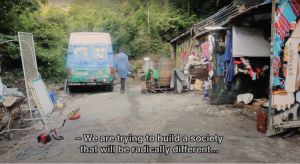
Screenshot from the film Landslide by Oleksiy Radynski, 2016, 29 min
The main narrative of the film is actually about this: about building something. What they build is the stairs that would connect the tickets to one of the main city squares, and a stage, reminiscent of an UFO, – an architectural object designed by Ukrainian artist and architect Dana Kosmina who was also an architect of the Ukrainian piazza at the Venice Biennial this year. What we see in this film is an emergence of a new public space in the city. This public space was created without any money, institutional or municipal support, only out of the common desire to create it.
For me this story is a perfect metaphor for the Ukrainian art between the revolutions and war, which was an ongoing attempt of creating something, some common space, out of nothing, relying on collective efforts. It also perfectly conveys the feeling that the concepts and models that worked for the previous generations are not relevant anymore, and the new and radically different one is to be invented.
What, I think, is a distinctive feature of Ukrainian art of the given period is a desire to create not only the artworks but the very social fabric in a radically (or somehow) different way, without waiting for any support from above. Of course, this desire was very much inspired by the experience of the revolutions.
The Orange Revolution happened in 2004 and was initially a protest against the faked elections. It was not the first time that the elections in Ukraine were faked. In the Soviet Union, the very event of the election was a big theatrical show with always and a predetermined finale. This long-standing practice of fake democracy created something like a bitter humility before the fact that politics is a corrupted game of those who have power and it’s not for the ordinary people to intervene there.
So the Orange Revolution was a big step for the so-called ordinary citizens to the political stage, to the realm of political decisions. and as far as this protest was successful, it was a big and inspiring revelation that ordinary citizens can influence the political life of the country.
What was also precious in the experience of the Orange Revolution was the practices and relationships that emerged in the course of it. That was the practices of solidarity, mutual support, collective action, and, last but not least, – the practical implementation of the right to the city and its public spaces as spaces that belong to the citizens and can operate as an arena of their political struggle.
The main conclusions that the young artists took from their revolutionary experience were:
-Collective effort makes real changes possible.
-Public space is there to be used by citizens.
This was the beginning of a new chapter in Ukrainian contemporary art marked by the emergence of artistic groups and collectives, grass-root exhibitions and art institutions based on collective volunteer efforts, engagement of artists with social and political issues, and a focus on the public space.
One of the brightest artistic offsprings of the Orange Revolution was the emergence of the REP group. The title is the abbreviation of the 3 words in ukrainian: Revolutionary Experimental Space (революційний експериментальний простір).
The story of the emergence of the group seems very telling to me. According to the legend, “In 2004, during the events of the Orange Revolution, a group of artists, working on the creation of the “street works” went to the Center of Contemporary Art at the National University “Kyiv-Mohyla Academy” to borrow a ladder, and…” They received not only it but also an invitation from the then-director of the institution, Jerzy Onuh, to use the centre’s premises as their open workshop.
Yuliya Vaganova, who worked at the Center during the period of R.E.P.’s residency, recalls that at that time the centre, which began its activities with blockbuster exhibitions of Andy Warhol and Joseph Beuys, “lost absolutely all funding and had to find it independently “: “The only thing we had was a free room.” It became an experimental space, where the director of the institution invited young artists, refusing any selection or admission procedures.
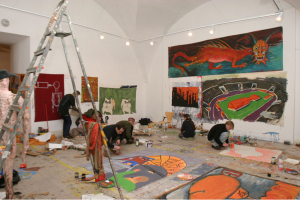
Open laboratory at the Soros Center of Contemporary Art at NaUKMA, Kyiv, 2004. Courtesy by the R.E.P. Group
Paradoxically, this new artist phenomenon emerged out of an institutional crisis and lack of funding.
During the initial stage of the open workshop, almost anyone could work there. The composition of the authors of the first exhibition, which eventually gave the name to the group, was very diverse, for some of them participation in the show was the first and sometimes the only such experience. Then in the group R.E.P., there were 20 participants. Gradually only 6 of them remain: Ksenia Hnylytska, Nikita Kadan, Zhanna Kadyrova, Volodymyr Kuznetsov, Lada Nakonechna, and Lesya Khomenko remain, while many others started their art practices.
This initial gesture of abolishing existing hierarchies and criteria that had regulated the art field was very productive and brought very powerful new energy to Ukrainian art.
The R.E.P. group daringly became widely discussed due to the series of actions in the public space known under the umbrella title “Intervention”. Due to their own revolutionary experience, they realized that they don’t need the galleries and institutions to express themselves and reach the audience. The street was a perfect stage that allowed them to address not the “audience of artistic events” but their co-citizens, which was a completely different mode of artistic activity.
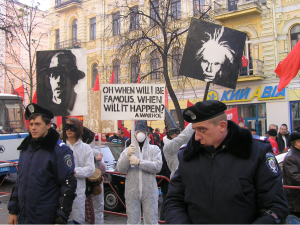
Intervention, WE WILL R.E.P. YOU. Action, video documentation, 2005. Courtesy by the R.E.P. Group
On November 7, the anniversary of the October Revolution, they did the action “We Will R.E.P. You!” along with a demonstration of the Communist Party and a rally of nationalist organizations. With quotes from Beuys and Warhol, “Everyone is an artist”, and “Oh when I will be famous, when will it happen?”, as well as their slogans they infiltrated the columns of other demonstrators and, breaking into the first ranks, led the march.
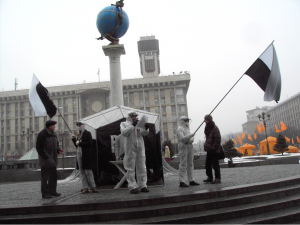
Intervention. R.E.P. Party. Action, video documentation, 2006. Courtesy by the R.E.P. Group
A tool often used by artists was a fabric tent that could easily be moved to the desired “hot spot” and, depending on the need turned into a gallery, then a trade stand, then a party propaganda station.
In 2006, during the election campaign, a campaign tent of the R.E.P. Party was placed on Independence Square to spread its program, part of which was “the introduction of modern art into the space of social communication”.

Intervention. R.E.P. Gallery. Action, video documentation, 2006. Courtesy by the R.E.P. Group
In the same year, they set up their tent near the National Art Museum, but already under the guise of “R.E.P. Gallery”. The intervention took place on the day of the official opening of the Niko Pirosmanishvili exhibition. Joining this highly publicized event, the group successfully took over part of the public and media attention assigned to the museum exhibition.
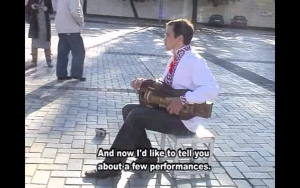
Mediators, Lyre player. Performance, video documentation, Kyiv, 2006. Courtesy by the R.E.P. Group
In 2006, the artists started another long-term project “Mediators” – a series of performances in the cities of Eastern Europe. During such performances, traditional masters of the oral genre (Ukrainian lyre player, Armenian as hug, Kazakh akin, and others) in their characteristic manner told the history of contemporary art to passers-by.
This performance shows perfectly the strategy of the group: without relying on any external structures they produced an artistic gesture and at the same time a context needed for it to be comprehended. they do a performance, which is at the same time an explanation of what performance is to the unprepared audience. so, they simultaneously produce a performance and its audience.
Relying on such practices of self-organization and, I would say, self-help, the group step by step expanded its initial practices and started functioning as a grass-roots art institution. Beyond their artistic actions or artworks, they started arranging exhibitions and events with other participants, building new artistic networks and structures of collaboration.
For example, in 2008 they placed a container near one of the central metro stations in Kyiv, where the exhibition “Common Space” took place: along with the documentation of the interventions of various artists and artistic groups in the city space, utopian projects of the transformation of this space were presented. The exhibition also continued on light boxes in the subway.
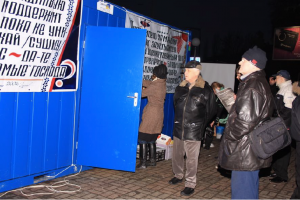
Exhibition “Common Space”, Kyiv, 2008. Courtesy by the R.E.P. Group
Yet, this exhibition didn’t last long, as the communal services dismantled the container the very next day after the opening. The official explanation of such a reaction was given by the Deputy Chairman of the Pechersk District Council: “We received numerous complaints from the area’s community regarding pornography; that offended people’s religious feelings.”
I don’t know whether this explanation corresponded the reality, or there were some other reasons behind the dismantling of the show, but here we face another important topic in Ukrainian contemporary art of the period.
As soon as artists embraced the revolutionary enthusiasm of turning public space into the locus of social and artistic experimentation, reflections, and discussions, they entered the zone of social and political antagonisms of the society, discovering that the “common space” is also a contested space structured with power relations, where struggle over dominance takes place.
In between Orange Revolution and Maidan Revolution, the whole range of art exhibitions or specific artworks were banned or censored, and one artist, Olexandr Wolodarsky, was even put to jail for his performance in front of the State Council of Ukraine. All of those cases of censorship or clashes with art had one thing in common: they took place when art dared to go beyond its “autonomous zone” protected by independent art institutions and tried to intervene in different areas of political and cultural life, entering either the urban public space or the space of different state-controlled institutions. In most cases, the acts of censorship resulted from voluntaristic decisions made by definite officials empowered to control the situation in specific areas; In all except one case the censored artistic events were self-organized and touched social issues.
This one exception was a specific artwork by Volodymyr Kuznetsov, which he did as his contribution to the glorious patriotic exhibition named “Grand and Grate” organized by the state art institution Art Arsenal, and which aimed to be an institutional critique.
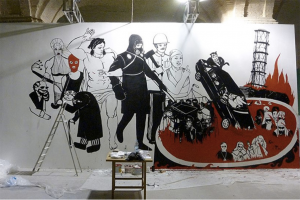
Unfinished work, “The Last Judgment”, Volodymyr Kuznetsov, 2013. Courtesy by the artist
The work was called “The Last Judgment” and depicted corrupted politicians and priests burning in hell as the Last Judgment made by revolted people. The curator of the show and the head of the institution, Natalia Zabolotna, covered the artwork with black paint just before the opening. Mrs Zabolotna explained her decision to destroy the artwork claiming that everything that is said against the fatherland she considers immoral. What she did not mention in her argument is that the former president of Ukraine, Victor Yanukovych, who was infamously overthrown during Maidan, and who is now officially recognized as a criminal, was expected to visit the opening of the exhibition. Covering the work by Volodymyr Kuznetsov, the curator seemingly tried to protect him and his accomplices-in-power from witnessing their upcoming inevitable future.
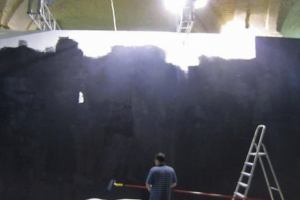
The Last Judgment” by Volodymyr Kuznetsov painted over by an employee of Art Arsenal. Source: https://lb.ua/culture/2015/10/05/317741_sud_naznachil_kuznetsovu_1_tis_grn.html
All those clashes over art were a continuation of the Orange Revolution and the harbingers of the Maidan, – as the main line of confrontation was between authoritarian power structures and emerging civil society that started to claim its right to the country. The demolition of Volodymyr Kuznetsov’s work (that happened just a few months before the Maidan), was a vain attempt to imitate the control over the situation that was already shaking. The next, and the last attempt to imitate the control over indignant society happened when the students’ protest that peacefully expressed dissatisfaction with the state politics was violently demolished by the police under the Yanukovich order. The act of ruthless violence of the ruling regime toward the peaceful citizens destroyed the last appearances of its legitimacy, bringing up the Maidan revolution.
Immediately after the Maidan and the overthrow of the pro-Russian corrupted President Yanukovych and his government, Russia annexed Crimea and started an invasion in the East of Ukraine trying to keep its influence in Ukraine with a brutal force.
The art that emerged after the Maidan, thus, is much less optimistic and ambitious than the art after the Orange Revolution.
Raft Crimea by Crimean artist Maria Kulikovska is one of those artworks that became for me a symbol of a post-maidan mood. After losing her home in Crimea, Maria created her own personal Crimea, on the rubber life raft. The raft first appeared at the Dnipro River, docked near the boardwalk. Maria lived there for three days without water and food, relying only on the support of her co-citizens that took care of her. After the 3d day the raft with Maria on board started moving down the river to reach and cross the water border with the EU, – the border on the Danube river that I crossed while escaping the war this year. At the border, she was stopped by the State Border Guard Service, interrogated, and released.
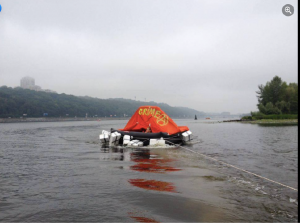
Raft Crimea. Maria Kulikovska, 2016. Picture by Lesia Kulchynska
Similarly to the actions of the REP group, Maria still in this action relies on the public space in her attempts to influence some social processes, initiating discussion on the situation of the displaced people. Yet, her performance is at the same time much more personal and melancholic, and is very much induced with the feeling of loneliness, longing for care and support, and desire to drift away from the disaster in a search for some illusory “better place”.
This strange mix of the feelings of loneliness and abandonment, and still, the attempts to create some tiny independent space of alternative reality is probably the main overton in Ukrainian art since the beginning of war.
The ongoing performance by the former member of the REP group, Borys Kashapov `Painting on Nails’ initiated in 2019 signals for me the further transformations of the initial revolutionary impulse that I started with. At first sight, he drifts away from the political ambitions of the revolution-inspired art of the REP group. But what he keeps is its independence from institutions and desire to establish direct unmediated (by institutions) relationships with his interlocutors.
Completely abandoning the attempts to struggle over the public space Boris still manages to smuggle his art there almost invisibly. He does his painting not on the canvas that should be then exhibited, but directly on the nails of his viewers, turning them into live nomadic art institutions that tour the nail exhibition wherever they go, discussing it with their friends or random interlocutors.
His practice is very modest: the performance takes the form not of political action, as in the case of REP, but of the face to face service; the artworks produced are of tiny scale, vanishing quickly, not bringing any profit and not claiming for bringing any significant changes into the world, except of spontaneous conversations.
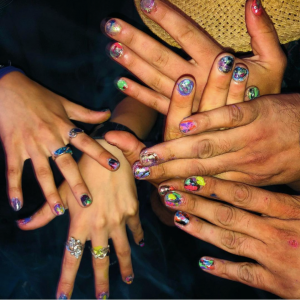
Painting on nails. Borys Kashapov, Kyiv, 2021. Courtesy by the artist
Yet, what is created with this performance is a tiny (a nail-scale) common ground.The very situation of painting on someone’s nails creates a precious possibility of being together with a stranger, taking a chance of experiencing a fleeting moment of mutual trust.
This longing for being together and the need to trust strangers is something that is left painfully unsatisfied after the collective body of Maidan is dissolved. For me, this performance is all about the need to fulfil this lack of lost social sympathy, but without resorting to any grand narratives or ideological projects.
And here I would like to go back to the words of another Borys, who claimed that he, together with his (marginalized) companions, is building a society that will be radically different. This statement probably sounds weird. Yet, during the full-scale war, one thing became especially palpable: amid the collapse, those tiny unruled interactions of mutual trust and care are the most solid building material for the society that, maybe, someday will become radically different.


